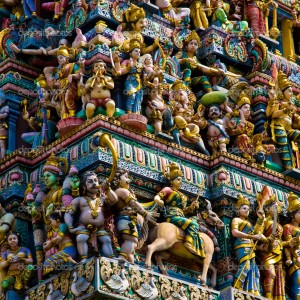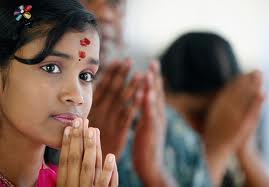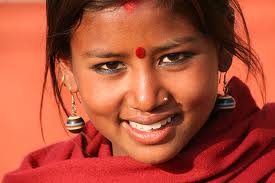What’s up with the ‘dot’ on the forehead, the worshiping of cows, the worshiping of idols and the polytheism? Is Yoga a Hindu practice, is the word ‘Hindu’ a proper term, and what’s up with the caste system?” Individuals asking these questions are usually not used to a religious tradition that has been maturing for over 7,000 years or one with profound and sophisticated philosophies attached. However, these questions are ones many have about Hinduism and are worth some examination.
 First of all, Hindus are not idol worshipers nor are we idle worshipers. If the statue in the temple breaks do Hindus think that god is dead? Of course not. These statues are made in a specific manner by artists who’ve been creating them for many generations. This artwork is their Yoga and Sadhana. They are to be in a state of “devotional” awareness via meditation during the production of the icon. Then the temple priests perform elaborate “awakening ceremonies” or time honored rituals, which brings in the awareness and embodiment of the absolute godhead in the form of a particular Deva or deity. By this sacred process, the statues become Murtis or embodiments of the divine. Then individual Hindus offer their love and devotion to the deity in various ways which strengthens their bond to the divine.
First of all, Hindus are not idol worshipers nor are we idle worshipers. If the statue in the temple breaks do Hindus think that god is dead? Of course not. These statues are made in a specific manner by artists who’ve been creating them for many generations. This artwork is their Yoga and Sadhana. They are to be in a state of “devotional” awareness via meditation during the production of the icon. Then the temple priests perform elaborate “awakening ceremonies” or time honored rituals, which brings in the awareness and embodiment of the absolute godhead in the form of a particular Deva or deity. By this sacred process, the statues become Murtis or embodiments of the divine. Then individual Hindus offer their love and devotion to the deity in various ways which strengthens their bond to the divine.
This is not unlike the Catholic transubstantiation ritual which transforms bread and wine into the body and blood of Christ. So it is not the statue or image itself which is being worshiped, though this aspect of the Murti holds importance in and of itself. It’s what is in and pervades the statue that is being worshiped. If no one had ever seen a phone, then one day saw someone speaking on the phone, would they not think that the person was speaking directly to the phone itself rather than a person on the other line?
 Secondly, let’s discuss polytheism. Again, to the Western/Christian eye, it appears on the surface that Hindus worship a multitude of deities. Hindus actually believe in one god that is pure consciousness, being and bliss. An unfathomable being that serves not only as creator but creation, preservation and transformation…the three aspects of god-in-action. This is seen as a being with no real persona, ego/individuality, body/sex…no real qualities whatsoever, other than Sat-Chit-Anand or Being, Consciousness and pure Bliss. Below this being are Devas and Devis, or male and female deities which are a part of the one god’s creation and part of the one god’s self; as are you and I.
Secondly, let’s discuss polytheism. Again, to the Western/Christian eye, it appears on the surface that Hindus worship a multitude of deities. Hindus actually believe in one god that is pure consciousness, being and bliss. An unfathomable being that serves not only as creator but creation, preservation and transformation…the three aspects of god-in-action. This is seen as a being with no real persona, ego/individuality, body/sex…no real qualities whatsoever, other than Sat-Chit-Anand or Being, Consciousness and pure Bliss. Below this being are Devas and Devis, or male and female deities which are a part of the one god’s creation and part of the one god’s self; as are you and I.
They are thought to dwell on a different Lokas (planes of existence) than we do, with the power to intervene and exist on our human plane as well. Westerners have lost in translation the true meaning and personification of these deities. Devas/Devis translates more to ‘angels’ than to ‘gods’ or ‘god’, in the Western/Christian sense. Hindus believe they are sacred, but we Hindus believe pretty much everything in nature and the universe is sacred because it is all a part of god, god-consciousness and his/her/its creation. Furthermore, these various deities signify various elements or powers in the natural world and/or psychological aspects of our own selves.
They are not beings which order or impose any sort of dogma upon mankind. They do not threaten mankind with hell or promise eternal reward in trade for believing in a certain manner. In the Hindu view, that is for training dogs to do tricks not for awakening the spiritual awareness of the individual aspirant.
 Thirdly, let’s talk a bit about “the sacred cow”. Hindus do not worship the cow. Hindus greatly revere the cow. The cow pulls the plow in the fields, gives milk, butter, yogurt and cheese; which in a vegetarian society is/was absolutely necessary. The cow gives it’s hide when it dies and while alive, the cow gives butter which can be made into ghee, which is/was used for oil in lamps. Cow’s dung is/was used as fuel. The smoke from the burning dung keeps away insects and has been shown to kill airborne pathogens. The dung is/was also used as a binding agent to build huts and is itself antibacterial. So anyone can see that Hindus appreciate cows. Without the cow, Bharata (India) would not be. However they are not worshipped “as gods
Thirdly, let’s talk a bit about “the sacred cow”. Hindus do not worship the cow. Hindus greatly revere the cow. The cow pulls the plow in the fields, gives milk, butter, yogurt and cheese; which in a vegetarian society is/was absolutely necessary. The cow gives it’s hide when it dies and while alive, the cow gives butter which can be made into ghee, which is/was used for oil in lamps. Cow’s dung is/was used as fuel. The smoke from the burning dung keeps away insects and has been shown to kill airborne pathogens. The dung is/was also used as a binding agent to build huts and is itself antibacterial. So anyone can see that Hindus appreciate cows. Without the cow, Bharata (India) would not be. However they are not worshipped “as gods
Imagine what Hindus think about the typical American carnivore who breeds the cow solely for the consumption of it’s flesh. To say that Hindus worship cows as gods is like saying that Christians slaughter cows because they believe the cows are evil demons.
 The “dot” on the forehead. For one to understand the true nature of the Teeka, one would have to understand the psychic/Ayurvedic perspective on anatomy. Specifically the system of chakras and auric sheaths. There are actually numerous symbols one might wear on the forehead for special occasions or to signify what sect of Hinduism the individual is from or follows.
The “dot” on the forehead. For one to understand the true nature of the Teeka, one would have to understand the psychic/Ayurvedic perspective on anatomy. Specifically the system of chakras and auric sheaths. There are actually numerous symbols one might wear on the forehead for special occasions or to signify what sect of Hinduism the individual is from or follows.
It’s main purpose is to remind the individual spiritual aspirant to look upon reality with the “mind’s eye” rather than just the physical eyes; which often only give half truths and delusions. In other words, the eyes only see that which is in the material, finite, outer world. The Teeka on the forehead reflects the notion of a spiritually infinite inner reality where the self and god are to be found.
 On the relationship between Yoga and Hinduism: The following simple quote by David Frawley says it best.
On the relationship between Yoga and Hinduism: The following simple quote by David Frawley says it best.
“Yoga is the science of meditation that appears in Hinduism as the very essence of its spiritual practice.”
The fact that Yoga is pursued by many non-Hindus is irrelevant to its validity as a Hindu practice. Hindu texts address the relation between the two quite often. To paraphrase: “The roots of Yoga, its scriptural origins, are Hindu. The stem of Yoga, its practice or sadhana, is Hindu. The flower of Yoga, its mystical union with god is Hindu. Yoga in its full glory and proper definition is fully Hindu.”
“When all the senses are stilled and brought into an inward focus, when the mind is at rest, when the intellect is one-pointed and wavers not…then is known the highest state of consciousness, Divinity and Yoga.
The calm of the five senses and the sixth sense which is mind has been defined as Yoga. He/She who attains it, finds freedom from delusion (Maya)”. ~ Katha Upanishad
 On the subject of the Varna/caste system: The Varna system was first discussed in the Rig Veda. It looked on the society of the ancient Indian republic as a person. The head (scholars and holy men), the arms (military and policemen), the body (merchants and businessmen) and the legs (workers and servicemen).
On the subject of the Varna/caste system: The Varna system was first discussed in the Rig Veda. It looked on the society of the ancient Indian republic as a person. The head (scholars and holy men), the arms (military and policemen), the body (merchants and businessmen) and the legs (workers and servicemen).
In recent history the “feet” or the “untouchable” has been added because of the severe poverty in India as well as the lingering shadow of colonialism which remains problematic in India and her cultural realm.
It is important to note that the caste system is not a Hindu problem. It is a socio-economic problem. To ridicule Hinduism because of it, is a common tool used by those of opposing religions to deline Hinduism as a whole. There have been over 80k rapes in American every year for over a decade. Yet people do not blame this statistical fact on Christianity. To blame the caste system on Hinduism is just a double standard.
 One can find the four groups of the Varna system in every developed society, ancient or modern. It is not a Hindu construct. When is the last time we’ve seen a Wall Street stock broker or the CEO of a corporation give an ardent hug to a homeless man who hasn’t showered in a month? Indeed, the caste system is alive and well everywhere, not just in India. In India, it is illegal to discriminate on the basis of one’s social status.’
One can find the four groups of the Varna system in every developed society, ancient or modern. It is not a Hindu construct. When is the last time we’ve seen a Wall Street stock broker or the CEO of a corporation give an ardent hug to a homeless man who hasn’t showered in a month? Indeed, the caste system is alive and well everywhere, not just in India. In India, it is illegal to discriminate on the basis of one’s social status.’
Finally, on the term “Hindu/Hinduism”: “Hinduism” is a great misnomer. People who practice it call it “Hinduism” for the purpose of understanding and simplicity. Many still refer to it properly as ‘Sanatana Dharma’ or the Eternal/natural Way/truth. The term “Hindu” was first coined by invading Persians who refered to those living within the Indus Valley as such.
 Towards the end of the 18th century, European colonists began to refer to the followers of Sanatana Dharma collectively as Hindus. The term was introduced into the English language in the 19th century to denote the vast religious, philosophical, and cultural traditions of India. So when the world uses a misnomer to myopically describe such a unique and vast tradition, it is any wonder there are so many misconceptions on the topic thriving today?
Towards the end of the 18th century, European colonists began to refer to the followers of Sanatana Dharma collectively as Hindus. The term was introduced into the English language in the 19th century to denote the vast religious, philosophical, and cultural traditions of India. So when the world uses a misnomer to myopically describe such a unique and vast tradition, it is any wonder there are so many misconceptions on the topic thriving today?
Hinduism is the mother of all religions. Arguably the “spiritual center” or hub of the world. It’s aspects can be found in Buddhism, Taoism, Jainism, Sikhism as well as the three Biblical religions. While no religion is without some dogmatic principles or aspects, Hinduism can afford many paths: Theists, non-theists, monotheists, polytheists, pantheists, agnostics and atheist. No other religious tradition can say this. Hinduism is not an organized religion as much as it is a personalized one.
It is a union of Eastern spiritualities which have evolved over many thousands of years, yet it remains relevant in modern times. It is truely a Sanatana Dharma…an Eternal and Universal way of understanding one’s self, divinity, nature and the cosmos. I am proud to be a Hindu Dharmi!
FB :Sean Bradrick www.yogaforyogis.org
































